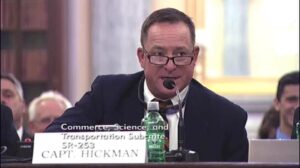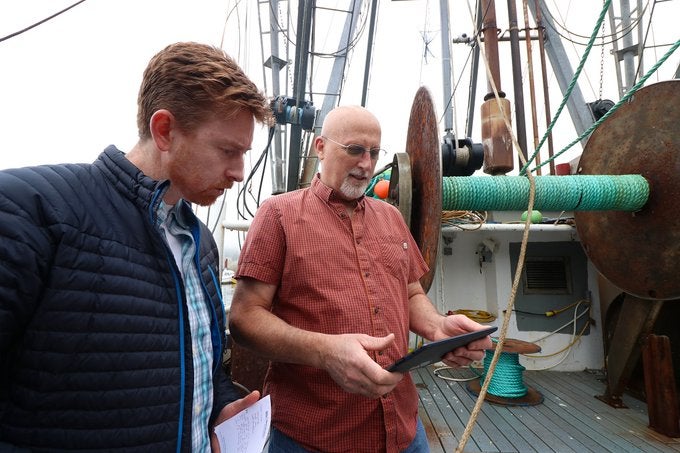By Allison Shields (EDF), Catherine Bruger (Ocean Conservancy), and Chris McGuire (The Nature Conservancy)
From smartwatches tracking our steps to news alerts on our phones to live traffic updates while driving, data has become central to our daily lives and how we interact with the world. For fishermen traveling miles offshore in search of fish, access to timely, accurate data is essential to their businesses, livelihoods, and communities. And now, from coast to coast, from commercial fishermen to weekend anglers, the fishing community is united by a common interest: fisheries data modernization.
What is fisheries data modernization? Simply put, it means strategically updating how we collect fisheries data and how we use it. Timely, reliable, and accurate data is essential to effectively manage fisheries at sustainable levels and ensure thriving coastal communities, but many of our fishery data systems are stuck in the past.
For decades, fisheries management, and subsequently fishing businesses, have been plagued by out-of-date software, siloed databases, and often antiquated data collection programs. But recently, fishermen’s voices have been getting louder, asking for federal guidance and more data collection programs that operate using modernized data systems. Facing challenges like rapidly changing ocean conditions and shifting fish stocks, there is a need for modernized data systems that will help fishery managers and stock assessment scientists be more effective in the face of climate change.
Validatable real-time data is a key component to sustainable fisheries  in our nation’s waters and the blue economy. New technologies are readily available to collect this data. Now is the time!” – Capt. Scott Hickman, Galveston, TX
in our nation’s waters and the blue economy. New technologies are readily available to collect this data. Now is the time!” – Capt. Scott Hickman, Galveston, TX
Fishermen from across the country are asking NOAA Fisheries to develop a National Strategic Plan for Data Modernization, and they recently reiterated their request both in letters to the administration and in meetings with lawmakers in Washington, D.C. This National Strategic Plan would provide guidance to improve data infrastructure and expand the use of electronic technologies so fishery scientists and managers can provide consistency and clarity for fishermen operating in a changing ocean.
Our organizations—Ocean Conservancy, The Nature Conservancy, and Environmental Defense Fund—have each worked with fishermen throughout the country on developing and implementing regional electronic technology programs, and we support the fishing industry’s interest in a National Strategic Plan for Data Modernization. Below, we highlight five key lessons learned from various regional programs and provide key insights that NOAA Fisheries should consider when developing the National Strategic Plan.
Consistency
With many different research programs, surveys, and data sources across U.S. fisheries, there is a need for consistent guidance and practices, as well as clear data standards. These standards would serve as minimum considerations that would enhance the consistency of programs and streamline the process for developing new programs. To help ensure data from different sources can be successfully combined and appropriately used in management, it must also be validated and calibrated.
Accessibility
As fish move in response to warming waters, more timely and accurate data will need to be shared within and across fisheries and regions. This increases the need for the agency to improve its siloed internal systems and establish a central database that integrates these various data streams. A modernized data management system will provide scientists and fisheries managers with easy and timely access to information. It can also reduce the effort and time lag from the point of collection to use in scientific assessments and management decisions.
Coordination
There needs to be better coordination and partnership between fishery managers and scientists at all levels of management—from the federal system, through the interstate commissions, to the individual states and even with external partners and research institutions. A more coordinated approach can reduce reporting burdens, allow for a more complete view of a fishery or region, and better address fishermen’s needs. Data collection programs, including those run by NOAA Fisheries, the states, and the commissions, must work closely to improve coordination and deliver better data to managers.
Transparency
Fishing groups are calling for these improvements because they know they can help deliver better-managed fisheries. They want to be partners in the development of a system that better meets their needs and those of fishery managers. A concerted effort needs to be made to engage fishermen and gain their trust and support. Greater transparency is a critical first step. Changes, improvements, and challenges that scientists and managers face should be clearly communicated. NOAA Fisheries and others in charge of administering data collection programs must also improve their engagement with the fishing community to bolster the use of electronic technologies.
Innovation
Given the need for more data and timely access to it, data collection and management systems should be designed and operated in ways that facilitate innovation. Fishery managers should consider how electronically reported data is integrated as accessible data systems can add to our overall picture of fisheries and address ongoing challenges. For example, cell phone applications could allow recreational anglers to report their catch, and that data could be used for tracking shifts in fish distribution due to climate change, report rare species, collect information on behavior such as discard rates, and potentially be validated for catch rates.
We hope that these insights can help NOAA Fisheries develop a National Strategic Plan for Data Modernization. Timely and reliable data is the foundation of effective fisheries management that benefits people and the planet. A national priority and strategic plan to modernize technology, policies, systems, and efficient use of data will help sustain American communities and ensure healthy and abundant fish populations for the future.










